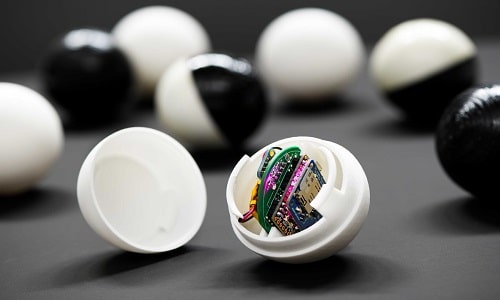Imagine a group of small-sized balls equipped with sensors flowing through your intestines in order to detect thickening. Or inspecting hard-to-reach environments such as pipeline networks of drinking water and oil systems to detect leakage. It all sounds like science fiction but can soon turn out to be a reality.

After much trial and error, a team of researchers led by Peter Baltus, professor of microelectronics at the department of Electrical Engineering at Eindhoven Institute of Technology, the Netherlands, have developed small circuit boards equipped with sensors that can easily fit into small golf-sized balls or marbles. While floating inside a pipeline network, these marbles have the ability to detect any obstructions, damages or leaks that are present.
Taking advantage of AI
However, operating them in an unfamiliar environment proved to be a huge challenge. To come up with a solution, the researchers decided to leverage the power of AI (Artificial Intelligence) that allowed the marbles to ‘evolve’ during the computer simulation process that was conducted afterward. This process was something as follows: after retrieving the collected data, an initial model of the pipeline was developed on a computer. A programmed algorithm then simulated the environment which the marbles had undertaken. It took about 500 simulation rounds to develop an optimal configuration that approximately matched the interior of the pipeline system. This simulation software (designed by AI) was then installed into the circuits within the marbles, which were then again released in the same pipeline system. This process was repeated three to five times in order to obtain the exact interior specifications of the pipeline.
“When you are unfamiliar with an environment, you also can’t know which features a sensor is going to need in order to explore that environment,” said Peter Baltus. “I draw a parallel with evolution because the process is so unpredictable. We don’t have a solution, so we let an algorithm do it. This algorithm mixes the most successful balls and works towards an optimum. We don’t know the results of that simulation process beforehand. Perhaps the algorithm decides to give each marble its own task, which could lead to location marbles and marbles that detect leakages. The fact that our first evolution experiment shows that the principle works are actually unbelievable, and they even evolve in the right direction as well.”
Magnetic energy for location detection
With one problem solved, another crept in – locating the exact position of the marbles where, for instance, a pipe burst had occurred. Unfortunately, GPS wasn’t capable of functioning underground. Therefore, the researchers employed ultrasonic acoustic waves. But the amount of energy it used (nearly 5000 times more than all the sensors and systems) proved to be unfeasible. Adding to that, the unidirectional transmission of data by ultrasonic waves was of no help in transmitting data in all directions.
So, the researchers came up with an alternative of using reversed magnetic fields with low frequency so that the signal is transmitted in every direction. Even though its range was limited to short distances, the objective of location detection corresponding to the relative positions of the marbles was achieved.
Fitting an emergency system
Initially, the marbles were designed to flow smoothly with the current flow, in order to reduce power consumption. But, in the event of it getting stuck in an area where the pipe is damaged, there was no way of restoring it back to normal operation. And that is why the marbles were later fitted with an emergency system.
“When a marble gets stuck, it uses its last bit of energy to send out a distress signal to the other balls nearby. In doing so, the marble also sends all the information it collected, so that no vital information is lost,” said Peter Baltus.
Way forward
Even though Baltus and his team of researchers have successfully demonstrated the technology, they want to continue forward this work in and implement it in healthcare. “We want to make the marbles even smaller, so that we can use them in healthcare, for example. Imagine that they’re small enough to flow through your blood vessels. That would bring entirely new possibilities to the detection of obstruction,” he said.
At the moment, the marbles are being used to detect leaks. But in the future, Baltus wants to develop a resin that closes it right away.
“We want to produce robust and affordable swarms of marbles and put them into use. We don’t need new inventions for that, but it will take a lot of hard work to solve all kinds of practical problems,” he said.









The article is very good. Thank you so much from the bottom of the heart for sharing this article.
Thank you for your feedback.